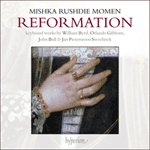In Shakespeare’s
Henry V (Act IV, sc 4), a French soldier greets Pistol, calling him a man of quality. ‘Quality? Calen O Casture me’ he replies, rather mysteriously, a probable reference to the song whose melody is used in this set of variations. Following a simple statement of the tune in C major (Ionian mode), there are five other variations. The first three gradually allow the left hand to take a predominant role, until the quavers at last break out in the right hand and lead to a final variation of greater exuberance. This is one of the most charming and tuneful of all Byrd’s sets of variations on popular Elizabethan tunes and may date from the 1590s. The lute stop, heard here in the left hand in the first part, was common on Flemish harpsichords of the period.
from notes by Davitt Moroney © 1999
Dans le
Henry V de Shakespeare (Acte IV, sc. 4), un soldat français dit que Pistol est un homme de qualité. “Quality? Calen O Casture me” répond mysterieusement Pistol, sans doute en référence à la chanson dont la mélodie est utilisée ici. Après la version simple de la chanson, en ut majeur (mode ionien), il y a cinq variations. Les trois premières valorisent progressivement la main gauche, jusqu’à ce que les croches de la main droite prennent le dessus, entraînant la musique vers une dernière section de grande exubérance. Ces variations qui datent peut-être des années 1590 sont parmi les plus charmantes et mélodiques de toutes les œuvres de Byrd basées sur des chansons. Le jeu de luth, entendu ici à la main gauche dans la première partie, se trouvait couramment sur les clavecins flamands de l’époque.
extrait des notes rédigées par Davitt Moroney © 1999


 Reformation
Reformation
